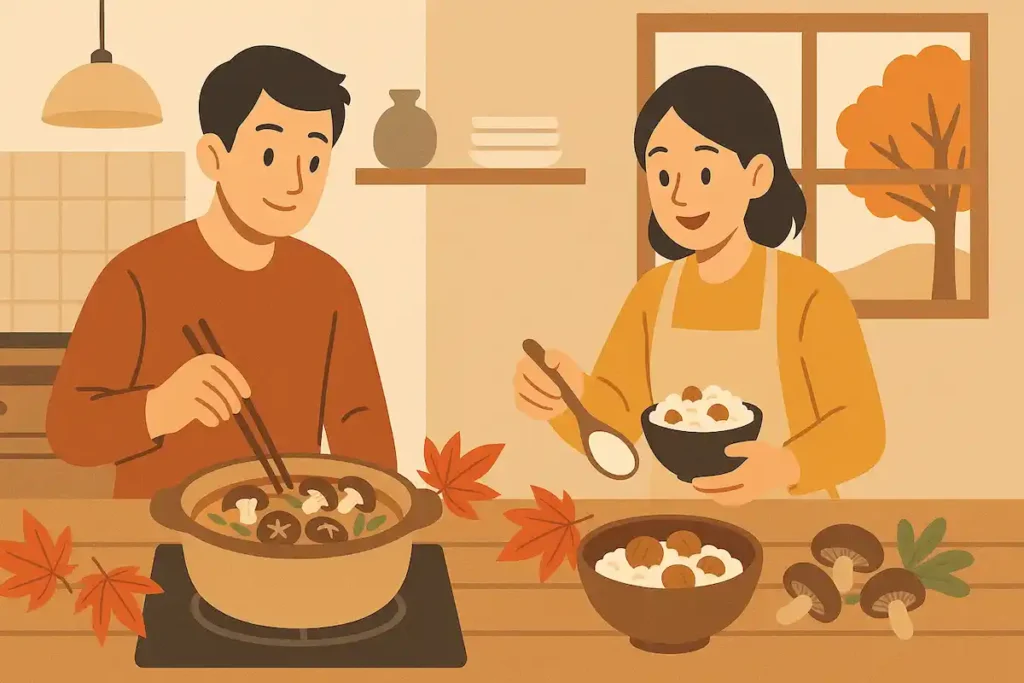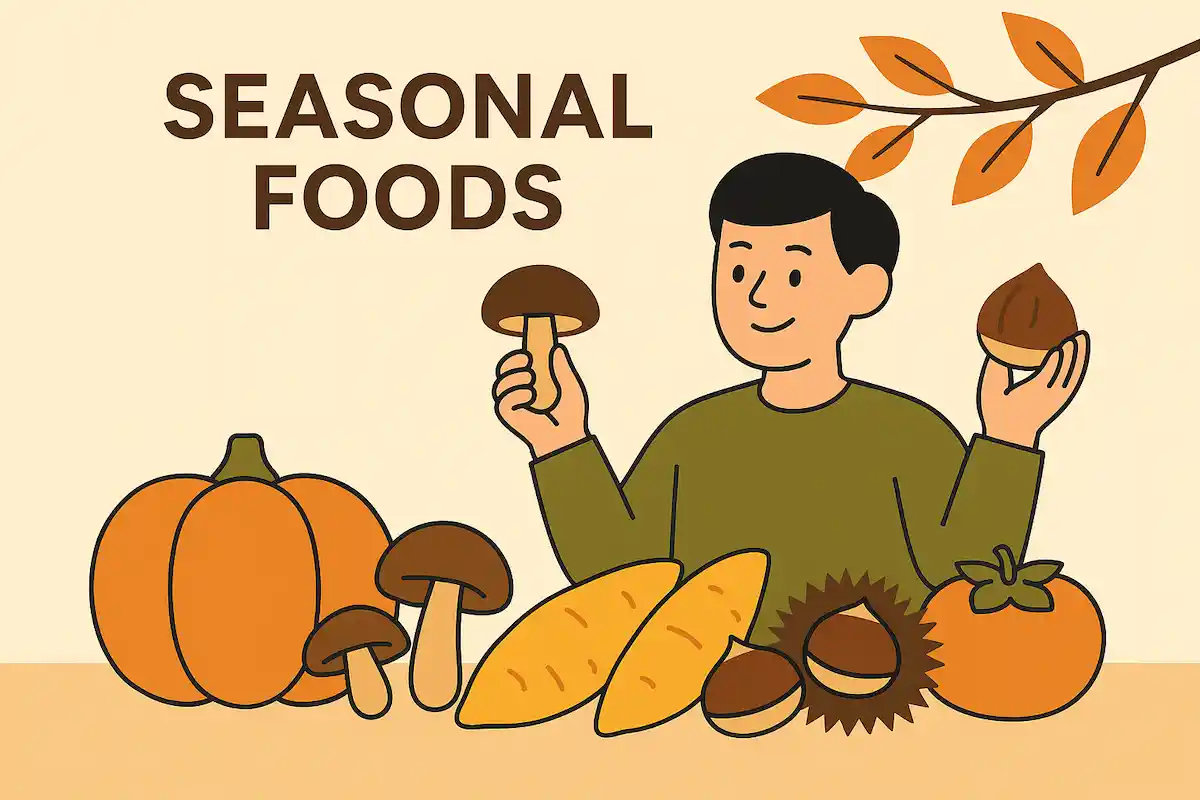旬の食材を英語で説明・紹介するための基本情報と、英会話に役立つ表現をシンプルでわかりやすい英語で紹介します。
英会話ダイアローグ・概要・10の質問を通して、旬の食材に関する英語表現を学びます。
英語
英会話ダイアローグを読む前に知っておくと良い前提知識と情報です。
- 「旬(しゅん)」の意味と考え方
- 旬の食材とは、一年の中で最もおいしく、栄養価が高く、たくさん収穫できる時期の食べ物
- 日本では、四季(春・夏・秋・冬)の変化に合わせて、旬の食材が入れ替わる
- 日本の四季と代表的な旬の食材
- 春:たけのこ、菜の花、初鰹、桜鯛、いちご
- 夏:きゅうり、トマト、なす、鰻、スイカ
- 秋:きのこ類、さつまいも、栗、柿、秋刀魚、戻り鰹
- 冬:白菜、大根、牡蠣、ふぐ、みかん
- 和食との関わり
- 和食では、旬の食材を使って季節を表
- 料理人は「味」「香り」「色」「盛りつけ」で季節感を演出
- 春の筍ご飯、夏の冷やしそうめん、秋の松茸ご飯、冬のおでんなどが典型的な例
- 地域の郷土料理との関係
- 各地には、その土地の気候や環境に合った旬の食材を使った郷土料理がある
- 秋田県のきりたんぽ鍋 : 新米を潰して棒状にし、きのこや鶏肉と煮込む鍋
- 高知県のかつおのたたき:鰹を表面だけ炙って薬味で食べる
- 各地には、その土地の気候や環境に合った旬の食材を使った郷土料理がある
- 旬の食材の魅力とメリット
- 一番おいしく食べられる時期に収穫されるため、味・香り・食感が最高
- 栄養価が高く、体を季節に合わせて整える効果
- 旬の時期は収穫量が多いため、価格が安定し、経済的
- 現代の課題
- 現代では温室栽培や輸入により、一年中同じ野菜や果物が手に入る
- 便利な反面、季節感が失われつつあるという懸念もある
- 「旬」を意識して食材を選ぶことが、日本文化の継承や環境保護の観点から見直されている
2人が旬の食材について話しています。
旬の食材の意味や特徴、和食との関わり、地域の郷土料理との関係などを話題にしています。
会話 / dialogue

Hey Key, lately I’ve been really curious about Japanese seasonal ingredients. People often say “shun no shokuzai,” right?

That’s right, Mack. “Shun” means the time when food is at its best — in taste, nutrition, and freshness.

So it’s about eating foods that are in season. But why is that so important in Japan?

Because Japan has four clear seasons, and each one brings different flavors.Using seasonal ingredients helps people feel the change of seasons through food.

I see. So, what are some examples? Like, what’s in season right now?

Since it’s autumn, mushrooms, sweet potatoes, chestnuts, and persimmons are at their best.They all have a rich, comforting taste perfect for cooler weather.

Sounds amazing! I had sweet potato tempura last week, and it tasted so natural and sweet.

Exactly! Seasonal ingredients have the best flavor because they grow under the right conditions.They’re also more nutritious and cheaper during their season.

That’s nice — tasty, healthy, and budget-friendly! Are they also linked to Japanese traditional dishes?

Absolutely. In Washoku, seasonal foods are the heart of the meal.
Chefs design menus to reflect the season — both in taste and in presentation.

Presentation too? Like how dishes look and feel?

Yes. For example, spring dishes use soft colors and fresh greens, while autumn dishes often have deep, warm tones. It’s like art on a plate.

That’s beautiful. I heard Washoku was registered as UNESCO Intangible Cultural Heritage. Is this idea of seasonality part of it?

Definitely. Washoku respects nature and the rhythm of the year. Eating seasonal foods means living in harmony with nature — that’s one of its core ideas.

That’s so different from eating the same food all year round.
It must help people appreciate the seasons more deeply.

Exactly. When you eat what the season gives you, you can taste spring’s freshness, summer’s brightness, autumn’s richness, and winter’s warmth.

I like that! It feels very connected to mindfulness — enjoying the moment.

Yes, it’s a kind of appreciation. And it’s not only about high-end restaurants — local dishes also come from seasonal ingredients.

Oh, you mean regional foods? Like local specialties?

Right. For example, kiritanpo nabe from Akita uses new rice and mushrooms in autumn, and katsuo no tataki from Kochi uses spring bonito fish.

So seasonal foods also show the local culture and people’s lifestyle.

Exactly. They tell you about the area’s climate, history, and how people live with nature. That’s why seasonal eating is a cultural experience.

Now I really want to travel around Japan and taste the different seasonal dishes!

That’s a great idea! Each region has its own seasonal flavors — and they’re all worth trying.

Thanks, Key. I think I’ll start with autumn dishes. Maybe a mushroom hot pot or chestnut rice!

Perfect choice. Enjoy the taste of the season — that’s the best way to experience Japan through food!
概要(旬の食材とは?日本の四季と和食中心の食文化)
「旬の食材」について、理解を深めるための「英語での概要」です。
旬の食材

What Are Seasonal Ingredients?
In Japan, “shun no shokuzai” means seasonal ingredients. These are foods that are at their best in flavor, nutrition, and freshness during a certain time of the year. Japan has four clear seasons — spring, summer, autumn, and winter — and each season offers different ingredients. People believe that eating foods in season is good for both the body and the mind. It helps people enjoy nature’s rhythm and live in harmony with the changing seasons.
Examples from Each Season
Each season has its own delicious foods. In spring, bamboo shoots and strawberries are popular. In summer, tomatoes, cucumbers, and watermelons help cool the body. Autumn brings sweet potatoes, chestnuts, and persimmons with a rich, warm taste. In winter, daikon radish, Chinese cabbage, and mandarin oranges are full of vitamins and sweetness. These ingredients make meals colorful and full of variety throughout the year.
Connection with Washoku
Seasonal ingredients are very important in Washoku, traditional Japanese cuisine.
Chefs use them to express the beauty of each season not only through taste but also through color and presentation. Eating seasonal food is one reason why Washoku was recognized by UNESCO as an Intangible Cultural Heritage. It shows respect for nature and a deep appreciation for seasonal changes.
Link to Local Food and Culture
Many local dishes in Japan also come from seasonal ingredients. For example, kiritanpo nabe in Akita uses autumn rice and mushrooms, and katsuo no tataki in Kochi uses spring bonito fish. Seasonal foods tell stories about the local climate, culture, and people’s lifestyle. By enjoying them, we can taste not only the flavor of the season but also the spirit of Japan itself.
10の質問(旬の食材の基本がわかるQ&A)
「旬の食材」について、理解を深めるための「英語での10の質問」です。

和訳付
会話 / dialogue

Hey Key, lately I’ve been really curious about Japanese seasonal ingredients. People often say “shun no shokuzai,” right?
ねえKey、最近「旬の食材」っていう日本の食べ物にすごく興味があるんだ。みんな「しゅんのしょくざい」ってよく言うよね?

That’s right, Mack. “Shun” means the time when food is at its best — in taste, nutrition, and freshness.
そうだよ、マック。「旬(しゅん)」っていうのは、食べ物が一番おいしくて、栄養もあって、新鮮な時期のことを言うんだ。

So it’s about eating foods that are in season. But why is that so important in Japan?
なるほど、つまり「今が一番おいしい時期の食材を食べる」ってことなんだね。でも、どうして日本ではそれがそんなに大事なの?

Because Japan has four clear seasons, and each one brings different flavors.Using seasonal ingredients helps people feel the change of seasons through food.
日本は四季がはっきりしていて、それぞれの季節に違う味が楽しめるんだ。旬の食材を使うことで、食を通して季節の移り変わりを感じられるんだよ。

I see. So, what are some examples? Like, what’s in season right now?
なるほどね。たとえば、今の季節だとどんな食材が旬なの?

Since it’s autumn, mushrooms, sweet potatoes, chestnuts, and persimmons are at their best.They all have a rich, comforting taste perfect for cooler weather.
今は秋だから、きのこ、さつまいも、栗、柿なんかが旬だね。どれも香りや甘みが豊かで、涼しくなってきた季節にぴったりなんだ。

Sounds amazing! I had sweet potato tempura last week, and it tasted so natural and sweet.
いいね!先週さつまいもの天ぷらを食べたんだけど、自然な甘さで本当においしかったよ。

Exactly! Seasonal ingredients have the best flavor because they grow under the right conditions.They’re also more nutritious and cheaper during their season.
そうそう!旬の食材はその季節の気候に合った環境で育つから、一番おいしいんだ。しかも栄養価が高いし、旬の時期は値段も手ごろなんだよ。

That’s nice — tasty, healthy, and budget-friendly! Are they also linked to Japanese traditional dishes?
なるほど、味もよくて健康的でお財布にもやさしいんだね!それって、和食とも関係があるの?

Absolutely. In Washoku, seasonal foods are the heart of the meal.Chefs design menus to reflect the season — both in taste and in presentation.
もちろんあるよ。和食では、旬の食材こそが料理の中心なんだ。料理人は味だけじゃなくて、見た目でも季節を表現するようにメニューを考えるんだよ。

Presentation too? Like how dishes look and feel?
見た目でも?つまり、盛りつけとか雰囲気でも季節を表すってこと?

Yes. For example, spring dishes use soft colors and fresh greens, while autumn dishes often have deep, warm tones. It’s like art on a plate.
そうそう。たとえば春の料理は淡い色や緑を多く使って、秋の料理は落ち着いた温かみのある色合いにするんだ。まるでお皿の上のアートみたいなんだよ。

That’s beautiful. I heard Washoku was registered as UNESCO Intangible Cultural Heritage. Is this idea of seasonality part of it?
すごいね。和食ってユネスコの無形文化遺産にも登録されてるって聞いたけど、季節感の考え方もその中に含まれてるの?

Definitely. Washoku respects nature and the rhythm of the year.Eating seasonal foods means living in harmony with nature — that’s one of its core ideas.
もちろんだよ。和食は自然や季節の流れを大切にしてるんだ。旬の食材を食べるっていうのは、自然と調和して生きることなんだよ。それが和食の基本的な考え方なんだ。

That’s so different from eating the same food all year round.It must help people appreciate the seasons more deeply.
一年中同じものを食べるのとは全然違うね。季節をもっと深く感じられるようになるんだろうな。

Exactly. When you eat what the season gives you, you can taste spring’s freshness, summer’s brightness, autumn’s richness, and winter’s warmth.
その通り。旬の食材を食べることで、春のさわやかさ、夏の明るさ、秋の深み、冬の温かみを味わえるんだ。

I like that! It feels very connected to mindfulness — enjoying the moment.
いいね!なんか「今この瞬間を味わう」っていうマインドフルネスにも通じる感じがするよ。

Yes, it’s a kind of appreciation. And it’s not only about high-end restaurants — local dishes also come from seasonal ingredients.
うん、まさに「感謝の気持ち」だね。それに高級料理だけじゃなくて、地方の郷土料理にも旬の食材が生かされてるんだよ。

Oh, you mean regional foods? Like local specialties?
なるほど、地域の料理ってこと?いわゆるご当地グルメみたいな?

Right. For example, kiritanpo nabe from Akita uses new rice and mushrooms in autumn, and katsuo no tataki from Kochi uses spring bonito fish.
そうそう。たとえば秋田の「きりたんぽ鍋」は秋の新米ときのこを使うし、高知の「カツオのたたき」は春に旬を迎えるカツオを使ってるんだ。

So seasonal foods also show the local culture and people’s lifestyle.
つまり、旬の食材って、その地域の文化とか人々の暮らしも表してるんだね。

Exactly. They tell you about the area’s climate, history, and how people live with nature.That’s why seasonal eating is a cultural experience.
その通り。気候とか歴史とか、人が自然とどう関わってきたかが見えてくるんだ。だから「旬を味わう」って、文化を体験することでもあるんだよ。

Now I really want to travel around Japan and taste the different seasonal dishes!
なんだか、日本中を旅して、いろんな季節の料理を食べてみたくなってきたよ!

That’s a great idea! Each region has its own seasonal flavors — and they’re all worth trying.
いいね!地域ごとに旬の味が全然違うから、どこに行っても新しい発見があると思うよ。

Thanks, Key. I think I’ll start with autumn dishes. Maybe a mushroom hot pot or chestnut rice!
ありがとう、Key。まずは秋の料理から始めようかな。きのこの鍋とか、栗ご飯とか食べたいな!

Perfect choice. Enjoy the taste of the season — that’s the best way to experience Japan through food!
いいね、その選択最高だよ!季節の味を楽しむことこそ、日本の食文化を感じる一番の方法だと思うよ。
概要(旬の食材とは?日本の四季と和食中心の食文化)
旬の食材

What Are Seasonal Ingredients?
In Japan, “shun no shokuzai” means seasonal ingredients.
These are foods that are at their best in flavor, nutrition, and freshness during a certain time of the year. Japan has four clear seasons — spring, summer, autumn, and winter — and each season offers different ingredients. People believe that eating foods in season is good for both the body and the mind. It helps people enjoy nature’s rhythm and live in harmony with the changing seasons.
日本では「旬の食材(shun no shokuzai)」とは、その季節に最もおいしく、栄養があり、新鮮な食べ物のことを指します。日本には春・夏・秋・冬の四季がはっきりあり、それぞれの季節に違う食材が楽しめます。旬の食材を食べることは、体にも心にも良いと考えられています。自然のリズムに合わせ、季節の変化と調和して生きることにつながるのです。
Examples from Each Season
Each season has its own delicious foods. In spring, bamboo shoots and strawberries are popular. In summer, tomatoes, cucumbers, and watermelons help cool the body. Autumn brings sweet potatoes, chestnuts, and persimmons with a rich, warm taste. In winter, daikon radish, Chinese cabbage, and mandarin oranges are full of vitamins and sweetness. These ingredients make meals colorful and full of variety throughout the year.
それぞれの季節には、おいしい旬の食べ物があります。春は、たけのこやいちごが人気です。夏は、トマトやきゅうり、スイカが体を冷やしてくれます。秋には、さつまいも、栗、柿など、深みのある温かい味わいの食材が旬を迎えます。冬は、大根、白菜、みかんなど、ビタミンが豊富で甘みのある食材が多く出回ります。これらの食材によって、一年を通して食卓が色鮮やかで、季節感にあふれるものになります。
Connection with Washoku
Seasonal ingredients are very important in Washoku, traditional Japanese cuisine. Chefs use them to express the beauty of each season not only through taste but also through color and presentation. Eating seasonal food is one reason why Washoku was recognized by UNESCO as an Intangible Cultural Heritage. It shows respect for nature and a deep appreciation for seasonal changes.
旬の食材は、和食と呼ばれる日本の伝統的な料理において、とても重要な存在です。料理人たちは、味だけでなく、色や盛りつけを通しても季節の美しさを表現します。旬の食材を大切にする考え方は、和食がユネスコの無形文化遺産に登録された理由のひとつでもあります。それは、自然への敬意と、季節の移ろいへの深い感謝の心を示しているのです。
Link to Local Food and Culture
Many local dishes in Japan also come from seasonal ingredients. For example, kiritanpo nabe in Akita uses autumn rice and mushrooms, and katsuo no tataki in Kochi uses spring bonito fish. Seasonal foods tell stories about the local climate, culture, and people’s lifestyle. By enjoying them, we can taste not only the flavor of the season but also the spirit of Japan itself.
日本各地の郷土料理も、旬の食材から生まれたものが多くあります。たとえば、秋田の「きりたんぽ鍋」は秋の新米ときのこを使い、高知の「カツオのたたき」は春のカツオを使います。旬の食材には、その土地の気候や文化、人々の暮らしが映し出されています。それらを味わうことで、季節の味だけでなく、日本の心そのものを感じ取ることができるのです。
10の質問(旬の食材の基本がわかるQ&A)
1: What does “shun no shokuzai” mean?
「旬の食材」とはどういう意味ですか?
“Shun no shokuzai” means seasonal ingredients. They are foods that taste best and have the most nutrition at a certain time of the year.
「旬の食材」とは季節の食材という意味です。これは、一年の中で最もおいしく、栄養価が高い時期の食べ物のことです。
2: Why are seasonal ingredients important in Japan?
なぜ日本では旬の食材が大切なのですか?
Because Japan has four clear seasons, and people enjoy the change of seasons through food. It also helps them live in harmony with nature.
日本には四季がはっきりしていて、人々は食を通して季節の変化を楽しみます。また、自然と調和して生きることにもつながります。
3: What are some examples of spring seasonal foods?
春の旬の食べ物にはどんなものがありますか?
In spring, bamboo shoots, strawberries, and clams are in season. They taste fresh and light.
春は、たけのこ・いちご・アサリなどが旬です。さわやかで軽やかな味が楽しめます。
4: What foods are popular in summer?
夏に人気の旬の食材にはどんなものがありますか?
In summer, people enjoy tomatoes, cucumbers, eggplants, and watermelons. These foods help cool the body in hot weather.
夏はトマト、きゅうり、なす、スイカなどが人気です。これらの食材は暑い季節に体を冷やしてくれます。
5: What kinds of foods are in season in autumn?
秋に旬を迎える食べ物にはどんなものがありますか?
Autumn is the season for sweet potatoes, chestnuts, mushrooms, and persimmons. They have a rich and warm flavor.
秋は、さつまいも、栗、きのこ、柿などが旬です。どれも深みのある温かい味わいがあります。
6: What are typical winter seasonal foods?
冬の代表的な旬の食べ物には何がありますか?
In winter, daikon radish, Chinese cabbage, spinach, and mandarin oranges are in season. They are full of vitamins and help keep the body warm.
冬は大根、白菜、ほうれん草、みかんなどが旬です。ビタミンが豊富で、体を温める働きがあります。
7: How are seasonal ingredients used in Washoku?
旬の食材は和食でどのように使われますか?
In Washoku, chefs use seasonal foods to show the beauty of each season. They express it through taste, color, and presentation.
和食では料理人が旬の食材を使って、季節の美しさを表現します。味や色、盛りつけを通してそれを伝えます。
8: What is the connection between seasonal foods and local dishes?
旬の食材と郷土料理にはどんな関係がありますか?
Many local dishes are made with seasonal ingredients. For example, kiritanpo nabe in Akita and katsuo no tataki in Kochi use local seasonal foods.
多くの郷土料理は旬の食材から作られています。たとえば秋田のきりたんぽ鍋や、高知のカツオのたたきなどは地元の旬の食材を使います。
9: What are the benefits of eating seasonal ingredients?
旬の食材を食べることの利点は何ですか?
Seasonal foods are tasty, healthy, and affordable. They are also good for the environment because they are often grown locally.
旬の食材はおいしくて健康的で、値段も手ごろです。また、地元で作られることが多いため、環境にもやさしいです。
10: What can we learn from the idea of eating in season?
旬の食材を食べるという考え方から何を学べますか?
We can learn to appreciate nature, enjoy the change of seasons, and understand Japanese culture more deeply through food.
自然を大切にする心や、季節の移ろいを楽しむこと、そして食を通じて日本文化をより深く理解することができます。

words & phrases
英会話ダイアローグと関連情報に出てきた単語・フレーズです(例文は各3つ)。

at its best : イディオム(句) /æt ɪts best/
意味: 最も良い状態で、最高の状態で。 In the best condition, quality, or form.
(旬の食材が「最もおいしい状態」にあることを表す)
例文:
- Seasonal ingredients are at their best in flavor and nutrition.
「旬の食材は、味と栄養の面で最も良い状態にあります。」 - This garden is at its best in spring.
「この庭は春に最も美しくなります。」 - Fresh strawberries are at their best in March.
「新鮮ないちごは3月が一番おいしい時期です。」
in season : イディオム(句) /ɪn ˈsiː.zən/
意味: 旬である、(食材が)出盛りの時期にある。Available and at its best time for eating or use.
(食べ物が「旬」であること、季節に合った食材を表す)
例文:
- Tomatoes are in season during summer.
「トマトは夏に旬を迎えます。」 - Fish taste better when they are in season.
「魚は旬の時期に食べるとよりおいしいです。」 - Strawberries are expensive when they are not in season.
「いちごは旬でない時期には高価です。」
comforting : 形容詞 /ˈkʌm.fə.tɪŋ/
意味: 心を落ち着かせる、安心させる。Making you feel calm, relaxed, or cared for.
(秋や冬の旬の食材の「温かく、心を満たす味わい」を表す)
例文:
- A bowl of miso soup is very comforting on a cold day.
「寒い日には味噌汁がとても心を温めてくれます。」 - Sweet potatoes have a comforting taste in autumn.
「秋のさつまいもは心を落ち着かせるような味わいです。」 - Her words were comforting after a long day.
「長い一日のあと、彼女の言葉は心を和ませてくれました。」
presentation : 名詞 /ˌprez.ənˈteɪ.ʃən/
意味: 盛りつけ、見た目、提示の仕方。The way something is shown or arranged, especially in food or art.
(和食における「料理の盛りつけ」や「見た目の美しさ」を表す)
例文:
- In Washoku, the presentation of food is as important as the taste.
「和食では、料理の盛りつけは味と同じくらい重要です。」 - The restaurant is famous for its beautiful presentation.
「そのレストランは美しい盛りつけで有名です。」 - Good presentation makes a meal look more delicious.
「美しい盛りつけは料理をよりおいしそうに見せます。」
seasonality : 名詞 /ˌsiː.zəˈnæl.ə.ti/
意味: 季節性、季節による変化。The fact that something changes or is available depending on the season.
(食文化や和食における「季節を大切にする考え方」を表す)
例文:
- Seasonality is an important part of Japanese food culture.
「季節性は日本の食文化の重要な要素です。」 - Washoku expresses the beauty of seasonality through color and taste.
「和食は、色や味を通して季節の美しさを表現します。」 - Chefs design menus that show the seasonality of ingredients.
「料理人は、食材の季節性を表すメニューを考案します。」
